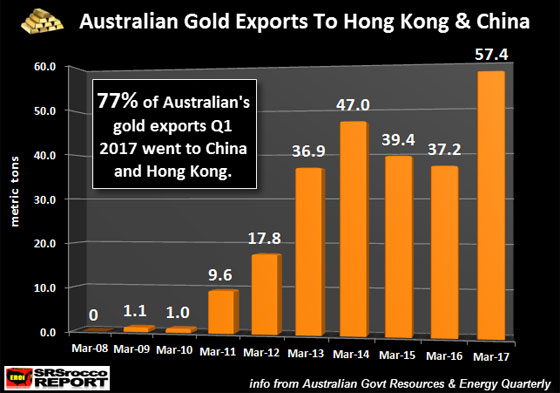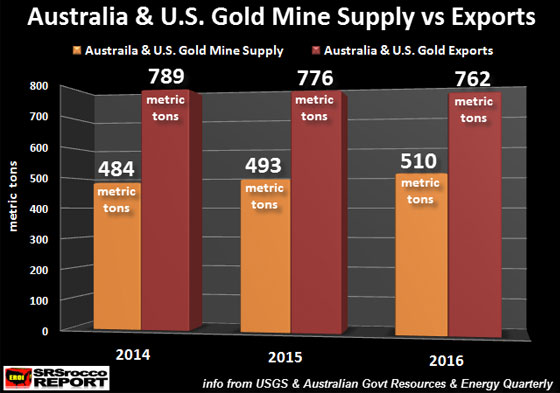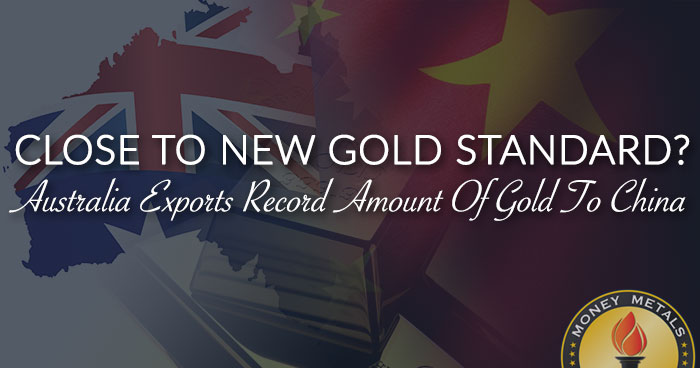Are the Chinese getting close to announcing a new gold-backed currency? Well, if the record amount of Australian gold exports into China is an indicator, it may be close at hand. While the Chinese have been importing a lot of gold from Australia, it reached a new record high in 2017.
According to the recently released data by the Australian Government June 2017 Resources and Energy Quarterly, Australia exported more gold to Hong Kong and China during the first quarter of 2017 than any other quarter in history.
Australia Exports
Australian gold exports to Hong Kong and China were 54% higher in Q1 2017 versus the same quarter last year:

As we can see in the chart above, Australia exported 57.4 metric tons (mt) of gold in Q1 2017 compared to 37.2 mt in Q1 2016. What a difference in ten years. Australian gold exports to Hong Kong and China were nonexistent in 2008. However, after the U.S. and global market meltdown that year, China started to import more gold, especially since 2011.
Even though I compared Q1 2017 Australian gold exports to China to the first quarters of previous years in the chart above, the data for all quarters shows that the present quarter is the highest amount on record.
Furthermore, Australia is now exporting the majority of its gold to Hong Kong and China. For example, of the total 75 mt of Australian gold exports in Q1 2017, 57.4 mt or 77% went to Hong Kong and China. Here was the breakdown for Q1 2017.
Australian Gold Exports Q1 2017:
Hong Kong & China = 57.4 mt
U.K. = 7 mt
Singapore = 2.1 mt
India = 2.0 mt
Thailand = 2.0 mt
Other = 4.5 mt
China Gold
In addition, of the 83 mt of Australian gold exports in Q4 2016, two-thirds made their way to Hong Kong and China. So, we can see that China is importing the most gold from Australia ever.
Now, what is even more interesting is that Australia exports more gold than they produce from its domestic gold mines. This is also true for the United States. I decided to take the gold mine supply and gold export figures from these two countries to produce the chart below:

Here we can see that Australia and the U.S. produced a combined 510 mt of gold in 2016, but their gold exports totaled 762 mt. Thus, these two countries exported nearly 50% more gold than they produced in 2016.
Here is a breakdown of Australian and U.S. gold mine supply and gold exports:
Australia Gold Production vs. Gold Exports
2014 = 274 mt Gold Mine supply vs. 289 mt Gold Exports (difference = +15 mt)
2015 = 279 mt Gold Mine supply vs. 282 mt Gold Exports (difference = +3 mt)
2016 = 288 mt Gold Mine supply vs. 329 mt Gold Exports (difference = +41 mt)
United States Gold Production vs. Gold Exports
2014 = 210 mt Gold Mine supply vs. 500 mt Gold Exports (difference = +290 mt)
2015 = 214 mt Gold Mine supply vs. 494 mt Gold Exports (difference = +280 mt)
2016 = 222 mt Gold Mine supply vs. 433 mt Gold Exports (difference = +211 mt)
While Australia is exporting more gold than it produces, the U.S. is the BIG WINNER here. As I have stated in previous articles, the U.S. is not only exporting more gold than it produces, but it is also exporting more gold than it imports.
In 2015, the United States produced 214 mt of gold and imported 265 mt for a total of 479 mt. However, the U.S. exported a total of 494 mt of gold in 2015. Which means, it exported 15 mt more gold than it produced and imported that year.
Regardless, Australia and the U.S. continue to export the majority of their gold to Hong Kong and China. For example, Australia and the United States exported 121 mt of gold to Hong Kong and China during the first quarter of 2017. Australia exported 57.4 mt, while the U.S. exported 63.3 mt. Thus, Hong Kong and China received 55% of all Australian and U.S. gold exports in Q1 2017.
Could the increase in Chinese gold imports suggest they are setting the stage for a new Gold-Back Currency or Trade? According to the recent article on Zerohedge, Moscow And Beijing Join Forces To Bypass US Dollar In Global Markets, Shift To Gold Trade:
The Russian central bank opened its first overseas office in Beijing on March 14, marking a step forward in forging a Beijing-Moscow alliance to bypass the US dollar in the global monetary system, and to phase in a gold-backed standard of trade.
....Speaking on future ties with Russia, Chinese Premier Li Keqiang said in mid-March that Sino-Russian trade ties were affected by falling oil prices, but he added that he saw great potential in cooperation. Vladimir Shapovalov, a senior official at the Russian central bank, said the two central banks were drafting a memorandum of understanding to solve technical issues around China’s gold imports from Russia, and that details would be released soon.
If Russia – the world’s fourth largest gold producer after China, Japan, and the US – is indeed set to become a major supplier of gold to China, the probability of a scenario hinted by many over the years, namely that Beijing is preparing to eventually unroll a gold-backed currency, increases by orders of magnitude.
For China (and Russia) to unroll a gold-backed currency, China must acquire as much gold as it can before the global currency reset. It is quite interesting to see the record amount of gold being exported from Australia to China as talks increase about a new Chinese-Russian gold-backed currency.
With the economic indicators in the U.S. and abroad peaking and rolling over, forecasts that a major market correction to take place towards the end of this year may indeed motivate China to roll out its gold-backed currency sooner rather than later. However, it’s a matter of WHEN, not IF the world moves to a new gold-backed currency system. Investors who continue to play RUSSIAN ROULETTE in the markets will likely be the biggest bag holders in history when the world switches over to a new gold-backed currency system.

About the Author:
Independent researcher Steve St. Angelo started to invest in precious metals in 2002. In 2008, he began researching areas of the gold and silver market that the majority of the precious metal analyst community has left unexplored. These areas include how energy and the falling EROI – Energy Returned On Invested – stand to impact the mining industry, precious metals, paper assets, and the overall economy.





